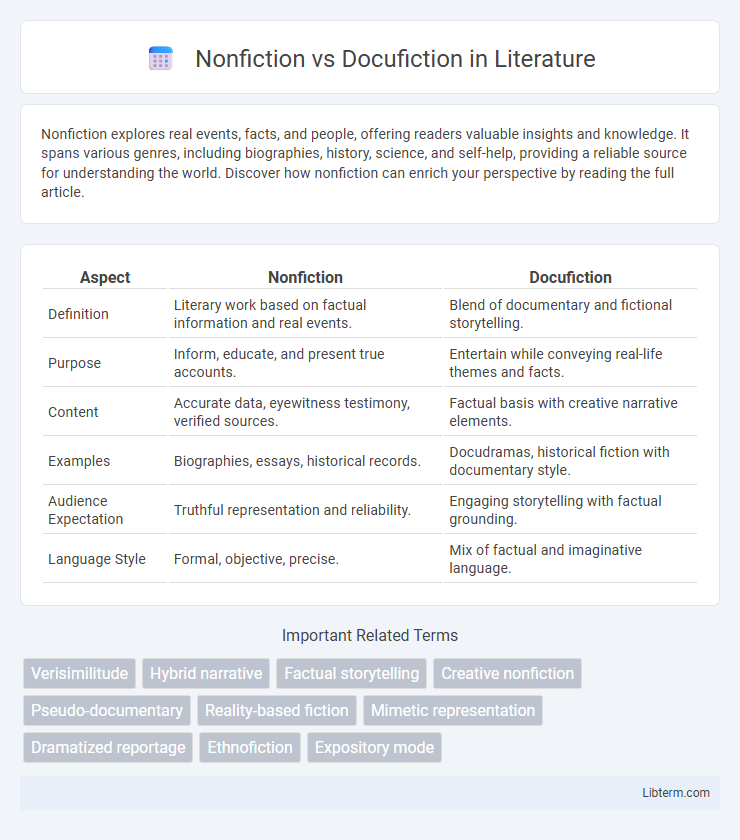Nonfiction explores real events, facts, and people, offering readers valuable insights and knowledge. It spans various genres, including biographies, history, science, and self-help, providing a reliable source for understanding the world. Discover how nonfiction can enrich your perspective by reading the full article.
Table of Comparison
| Aspect | Nonfiction | Docufiction |
|---|---|---|
| Definition | Literary work based on factual information and real events. | Blend of documentary and fictional storytelling. |
| Purpose | Inform, educate, and present true accounts. | Entertain while conveying real-life themes and facts. |
| Content | Accurate data, eyewitness testimony, verified sources. | Factual basis with creative narrative elements. |
| Examples | Biographies, essays, historical records. | Docudramas, historical fiction with documentary style. |
| Audience Expectation | Truthful representation and reliability. | Engaging storytelling with factual grounding. |
| Language Style | Formal, objective, precise. | Mix of factual and imaginative language. |
Introduction to Nonfiction and Docufiction
Nonfiction presents factual information and real events through narratives grounded in accuracy and evidence, serving educational, informative, or historical purposes. Docufiction blends documentary and fictional elements to enhance storytelling while maintaining a foundation in real-life events, often using creative techniques to fill gaps or interpret facts. Understanding their distinctions allows audiences to assess the balance between truth and artistic license in media content.
Defining Nonfiction: Key Characteristics
Nonfiction is defined by its basis in factual information, real events, and authentic experiences, emphasizing accuracy and truthfulness. It typically includes genres such as biographies, essays, documentaries, and journalistic reports that aim to inform, educate, or provide insight without fictional embellishment. Key characteristics include verifiable content, objective narration, and adherence to real-world evidence and sources.
Understanding Docufiction: Blurring Reality and Fiction
Docufiction blends factual documentary elements with fictional storytelling, creating a hybrid genre that challenges traditional boundaries between reality and imagination. This format allows filmmakers to explore truth through dramatized scenarios, enhancing emotional engagement without compromising factual integrity. Understanding docufiction involves recognizing its purpose to provoke critical thinking by destabilizing the viewer's perception of authenticity.
Historical Evolution of Nonfiction and Docufiction
Nonfiction has evolved from early historical chronicles and eyewitness accounts to complex analytical works grounded in factual accuracy and evidence. Docufiction emerged in the 20th century as a hybrid genre blending documentary authenticity with fictional storytelling techniques to enhance narrative engagement. This evolution reflects shifting audience demands for informative content delivered through immersive, dramatized experiences.
Major Differences Between Nonfiction and Docufiction
Nonfiction presents factual, verifiable information based on reality, emphasizing accuracy and objective truth without fictional elements. Docufiction combines documentary and fictional storytelling techniques, blending factual content with dramatized scenes or characters to enhance narrative engagement. The major difference lies in nonfiction's strict adherence to factual representation, while docufiction allows creative liberties to interpret or illustrate reality.
Purpose and Intent: Why Authors Choose Each Genre
Nonfiction aims to present factual information and real events with accuracy, serving the purpose of educating or informing readers based on truth and evidence. Docufiction blends factual content with fictional elements to create a compelling narrative that engages audiences emotionally while conveying underlying truths. Authors choose nonfiction to provide clarity and reliability, whereas docufiction attracts readers seeking both authenticity and creative storytelling.
Popular Examples of Nonfiction and Docufiction Works
Popular nonfiction works such as "Into Thin Air" by Jon Krakauer and "The Immortal Life of Henrietta Lacks" by Rebecca Skloot offer fact-based narratives grounded in real events and thorough research. In contrast, docufiction examples like the film "The Thin Blue Line" by Errol Morris and "F for Fake" by Orson Welles blend documentary footage with fictionalized elements to tell compelling stories that challenge traditional nonfiction boundaries. These works illustrate the diverse approaches to storytelling within nonfiction and docufiction genres, balancing factual accuracy with creative interpretation.
Impact on Audience: Trust, Engagement, and Perception
Nonfiction relies on factual accuracy and verifiable sources to build trust and credibility, fostering a strong connection with audiences seeking authenticity. Docufiction blends documentary and fictional elements, enhancing engagement through creative storytelling while risking blurred lines that can affect audience perception of truth. The impact on audience varies as nonfiction reinforces trust and education, whereas docufiction invites critical interpretation and emotional involvement.
Ethical Considerations in Nonfiction vs Docufiction
Ethical considerations in nonfiction demand strict adherence to factual accuracy, transparency, and respect for subjects' privacy to maintain credibility and trustworthiness. Docufiction blurs the lines between reality and dramatization, raising concerns about misrepresentation, manipulation of facts, and potential audience deception. Ensuring clear disclosure of fictional elements in docufiction is crucial to uphold ethical standards and protect the integrity of both the narrative and its subjects.
Future Trends in Nonfiction and Docufiction Writing
Future trends in nonfiction and docufiction writing emphasize immersive storytelling through advanced technologies like virtual reality and AI-assisted research, enhancing authenticity and reader engagement. The blending of factual accuracy with narrative creativity in docufiction will increasingly challenge traditional genre boundaries, driven by audience demand for compelling, credible content. Data-driven insights and interactive platforms will shape how nonfiction and docufiction are crafted and consumed, fostering a dynamic relationship between writers and readers.
Nonfiction Infographic

 libterm.com
libterm.com